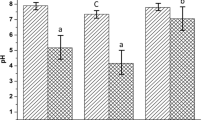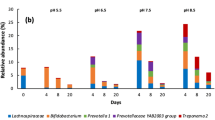Abstract
Different mixtures of animal byproducts, other slaughterhouse waste (i.e., rumen, stomach and intestinal content), food waste, and liquid manure were codigested at mesophilic conditions (37°C) at laboratory and pilot scale. Animal byproducts, including blood, represent 70–80% of the total biogas potential from waste generated during slaughter of animals. The total biogas potential from waste generated during slaughter is about 1300 MJ/cattle and about 140 MI/pig. Fed-batch digestion of pasteurized (70°C, 1h) animal byproducts resulted in a fourfold increase in biogas yield (1.14L/g of volatile solids [VS]) compared with nonpasteurized animal bypproducts (0.31L/g of VS). Mixtures with animal byproducts representing 19–38% of the total dry matter were digested in continuous-flow stirred tank reactors at laboratory and pilot scale. Stable processes at organic loading rates (OLRs) exceeding 2.5g of VS/(L·d) and hydraulic retention times (HRTs) less than 40 d could be obtained with total ammonia nitrogen concentrations (NH4−N+NH3−N) in the range of 4.0–5.0 g/L. After operating one process for more than 1.5 yr at total ammonia nitrogen concentrations >4 g/L, an increase in OLR to 5 g of VS/(L·d) and a decrease in HRT to 22 d was possible without accumulation of volatile fatty acids.
Similar content being viewed by others
References
Mathisen, B. (1997), in Proceedings of the 5th FAO/SREN Workshop, Verstrate, W., ed., REUR Technical Series 52, Rome, pp. 257–261.
Hjort-Gregersen, K. (1999) Report, Centralised Biogas Plant—Integrated Energy Production, Waste Treatment and Nutrient Redistribution Facilities, Danish Institute of Agricultural and Fisheries Economics, Esbjerg, Denmark.
Council Directive 90/667/EEC, Official Journal of the European Communities, Brussel, Belgium.
Danell, L. (1979), Report, Biproduktsmätningar storboskap 1977–78, Rapport från avräkningskommittén, Slakteriförbundet.
Thyselius, L. and Edström, M. (1994), in Proceedings of the 4th FAO/SREN Workshop, Marchaim, U. and Ney, G., eds., REUR Technical Series 33, Rome, pp. 254–261.
Wikberg, A., Blomberg, M., and Mathisen, B. (1998), AFR-report 234, Naturvårdsverket, Stockholm.
Oeschner, H. and Gosch, A. (1998), in Kofermentation, Arbeitspapier 249, Biskupek, B., ed. KTBL, Darmstadt, pp. 17–28.
Braun, R. and Kirchmayr, R. (2000), in Proceedings of Biogas Event 2000, Nordberg, A., ed., Swedish National Energy Administration, Eskilstuna, Sweden, pp. 14.1–14.7.
Lindberg, A. (1995) JTI Report Kretslopp & Avfall no. 1. Institutet för jordbruksmiljöteknik, Uppsala, Sweden.
Tritt, W. P. and Schuchardt, F. (1992), Bioresour. Technol. 41, 235–245.
Örlygsson, J., Houwen, F. P., and Svensson, H. B. (1993), Swed. J. Agric. Res. 24, 45–54.
Jarvis, Å., Nordberg, Å., Mathisen, B., and Svensson, B. H. (1995), Antonie Leeuwenhoek 68, 317–327.
APHA. (1985). Standard Methods for the Examination of Water and Wastewater, 16th ed., American Public Health Association, Washington, DC.
Kirchmayr, R., Steffen, R., Grasmug, M., et al. (2001), in Proceedings of the 9th World Congress Anaerobic Digestion 2001-Anaerobic Conversion for Sustainability, part 1, van Velsen, A. F. M. and Verstraete, W. H., ed., Technologisch Instituut vzw, Antwerpen, Belgium, pp. 469–472.
van Velsen, A.F.M. (1979), Water Res. 13, 995–999.
Angeledaki, I. and Ahring, B. K. (1993), Appl. Microbiol. Biotechnol. 38, 560–563.
Koster, I. W. and Lettinga, G. (1984), Agric. Wastes 9, 205–216.
Braun, R., Huber, P., and Meyrath, J. (1981), Biotechnol. Lett. 3, 159–164.
Angeledaki, I. and Ahring, B. K. (1994), Water Res. 28(3), 727–731.
Wellinger, A. (2000), in Anaerobic Digestion: Making Energy and Solving Modern Waste Problems, Ørtenblad, H., ed., AD-NETT, Herning, Denmark, pp. 8–21.
Wikberg, A. (1996), Licentiate of Engineering Thesis at the Royal Institute of Technology, Department of Chemical Engineering and Technology, TRITA-KET R 57, Stockholm, Sweden.
Angeledaki, I. and Ahring, B. K. (1992), Appl. Microbiol. Biotechnol. 37, 808–812.
Salminen, E., Rintala, J., Lokshina, L. Y., and Vavilin, V. A. (2000), Water Sci. Technol. 41(3), 33–42.
Author information
Authors and Affiliations
Corresponding author
Rights and permissions
About this article
Cite this article
Edström, M., Nordberg, Å. & Thyselius, L. Anaerobic treatment of animal byproducts from slaughterhouses at laboratory and pilot scale. Appl Biochem Biotechnol 109, 127–138 (2003). https://doi.org/10.1385/ABAB:109:1-3:127
Issue Date:
DOI: https://doi.org/10.1385/ABAB:109:1-3:127




